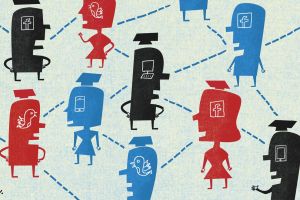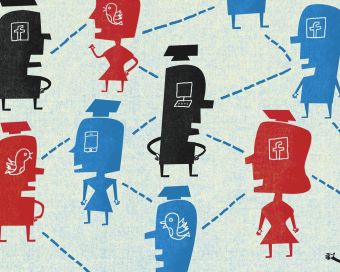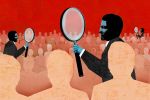A few months back, I gave a lunchtime talk called "Digital Humanities: Singular or Plural?" My title was in part a weak joke driven primarily by brain exhaustion. As I sat at the computer putting together my remarks, which were intended to introduce the field, I'd initially decided to title them "What Is Digital Humanities?" But then I thought "What Is the Digital Humanities?" sounded better, and then I stared at the screen for a minute trying to decide if it should be "What Are the Digital Humanities?" And in my pre-coffee, underslept haze, I honestly couldn't tell which one was correct.
At first this was just a grammatical mixup, but at some point it occurred to me that it was actually a useful metaphor for something that's been going on in the field of late. Digital humanities has gained prominence in the last couple of years, in part because of the visibility given the field by the use of social media, particularly Twitter, at the Modern Language Association convention and other large scholarly meetings. But that prominence and visibility have also produced a fair bit of tension within the field—every "What is Digital Humanities?" panel aimed at explaining the field to other scholars winds up uncovering more differences of opinion among its practitioners. Sometimes those differences develop into tense debates about the borders of the field, and about who's in and who's out.
![]() IN THE RIGHT COLUMN: More on The Digital Campus
IN THE RIGHT COLUMN: More on The Digital Campus
BROWSE THE FULL ISSUE: News, Commentary, and Data
BUY A COPY: Digital and Print Editions at the Chronicle Store
My first stab at trying to define digital humanities came in a post I wrote in July 2010 for The Chronicle's ProfHacker blog. In that post, I wrote that the digital humanities could be understood as "a nexus of fields within which scholars use computing technologies to investigate the kinds of questions that are traditional to the humanities, or, as is more true of my own work, ask traditional kinds of humanities-oriented questions about computing technologies."
There is, however, a specific history to the term "digital humanities," detailed by my friend (and scholar of English) Matthew Kirschenbaum in a 2010 article in the Association of Departments of English Bulletin. In 2001 the field was known as "humanities computing," and had been around for some decades, when Susan Schreibman, Ray Siemens, and John Unsworth, three of its key practitioners, entered into discussions with Blackwell Publishing about editing a volume prospectively entitled "A Companion to Humanities Computing." Blackwell wanted a title that might appeal to a wider range of readers, and so proposed "A Companion to Digitized Humanities." Unsworth countered with "Digital Humanities," to keep the field from appearing to be about mere digitization. And the name has stuck, helping to characterize a robust area of research and teaching supported by a number of prestigious conferences, well-received journals, scholarly societies, and even a dedicated office within the National Endowment for the Humanities.
Digital humanities thus grows specifically out of an attempt to make "humanities computing," which sounded as though the emphasis lay on the technology, more palatable to humanists in general. The field's background in humanities computing typically, but far from exclusively, results in projects that focus on computing methods applicable to textual materials. Some of these projects have been editorial and archival in nature, producing large-scale digital text collections for scholarly study. One such project is the William Blake Archive, which presents carefully annotated scholarly editions of both the writing and visual art of the Romantic-era British poet. It is sponsored by the Library of Congress and supported by the Universities of North Carolina at Chapel Hill and Rochester, and a division of the NEH.
Tools and technical standards to support the production of such archives have been another key source of digital-humanities work, including projects like the Text Encoding Initiative or the Text-Image Linking Environment. There are projects that focus on processing those large collections through a statistical analysis of a text's linguistic features, for example, or author-attribution studies or studies that rely on data mining. And there are initiatives that are designed to help digital-humanities archives and projects become interoperable and to facilitate the peer review of these projects.
Digital humanities as it is currently practiced isn't just located in literary-studies departments; the field is broadly humanities-based, and includes scholars in history, musicology, performance studies, media studies, and other fields that can benefit from bringing computing technologies to bear on traditional humanities materials.
However, when many of us hear the term "digital humanities" today, we take the referent to be not the specific subfield that grew out of humanities computing but rather the changes that digital technologies are producing across the many fields of humanist inquiry. Disciplines such as rhetoric and composition, for instance, have long been interested in the difference that the computer makes in contemporary writing and communication, as has digital-media studies.
It's clear that there's an overlap between these fields and that which has been called "digital humanities"—between scholars who use digital technologies in studying traditional humanities objects and those who use the methods of the contemporary humanities in studying digital objects—but clear differences lie between them. Those differences often produce significant tension, particularly between those who suggest that digital humanities should always be about making (whether making archives, tools, or new digital methods) and those who argue that it must expand to include interpreting.
The terms of this tension should begin to sound a bit familiar: It's an updated version of the theory-practice divide that has long existed in other quarters of the humanities. There has long been a separation, for instance, between studio artists and art historians, or between literary scholars and creative writers, and that separation can often lead to profound misunderstandings and miscommunications. In media studies, however, we've been reckoning with the theory-practice divide for some time. After much tension between media makers and media scholars, an increasing number of programs are bringing the two modes together in a rigorously theorized praxis, recognizing that the boundaries between the critical and the creative are arbitrary. In fact, the best scholarship is always creative, and the best production is always critically aware. The digital humanities seems another space within the academy where the divide between making and interpreting might be bridged in productive ways.
Does that mean we should throw open the floodgates and declare all forms of humanities scholarship that come into contact with the digital to be "digital humanities"? Should we expand the definition of the field to include, as I've heard it said several times, "every medievalist with a Web site"? Undoubtedly not: Just as there are scholars who write about film from perspectives that don't take into account the intellectual history of film studies, and thus are not considered part of the field, there are scholars who work with digital materials but who remain outside the traditions and assumptions of the digital humanities.
That fact doesn't diminish the usefulness of the debates about the borders of the digital humanities as a discipline, however. As Neil Fraistat, director of the Maryland Institute for Technology in the Humanities, pointed out in a recent talk at the University of Texas at Austin, these debates can be most productive if we understand them as a means of opening ourselves to the kinds of conversations that true interdisciplinarity can support. While disciplinarity is often institutionally useful, after all—allowing for the development of centers, departments, and tenure lines—it can also be turned against its adherents, restricting their movement and disciplining, literally, the knowledge they produce.
The state of things in digital humanities today rests in that creative tension, between those who've been in the field for a long time and those who are coming to it today, between disciplinarity and interdisciplinarity, between making and interpreting, between the field's history and its future. Scholarly work across the humanities, as in all academic fields, is increasingly being done digitally. The particular contribution of the digital humanities, however, lies in its exploration of the difference that the digital can make to the kinds of work that we do, as well as to the ways that we communicate with one another. These new modes of scholarship and communication will best flourish if they, like the digital humanities, are allowed to remain plural.









